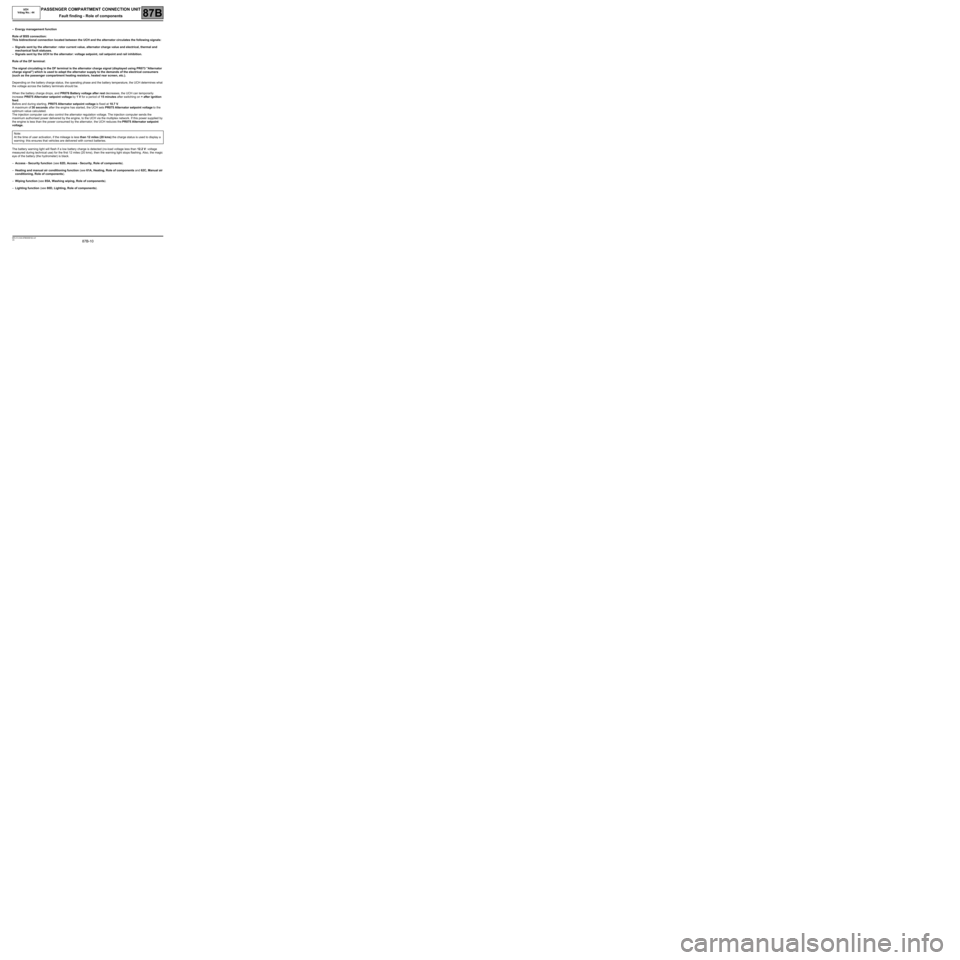mileage RENAULT TWINGO 2009 2.G Engine And Peripherals Passenger Compartment Connection Unit OBD Workshop Manual
[x] Cancel search | Manufacturer: RENAULT, Model Year: 2009, Model line: TWINGO, Model: RENAULT TWINGO 2009 2.GPages: 179, PDF Size: 0.57 MB
Page 10 of 179

87B-10
MR-413-X44-87B000$192.mif
V5
UCH
Vdiag No.: 44PASSENGER COMPARTMENT CONNECTION UNIT
Fault finding - Role of components87B
–Energy management function
Role of BSS connection:
This bidirectional connection located between the UCH and the alternator circulates the following signals:
–Signals sent by the alternator: rotor current value, alternator charge value and electrical, thermal and
mechanical fault statuses.
–Signals sent by the UCH to the alternator: voltage setpoint, rail setpoint and rail inhibition.
Role of the DF terminal:
The signal circulating in the DF terminal is the alternator charge signal (displayed using PR073 "Alternator
charge signal") which is used to adapt the alternator supply to the demands of the electrical consumers
(such as the passenger compartment heating resistors, heated rear screen, etc.).
Depending on the battery charge status, the operating phase and the battery temperature, the UCH determines what
the voltage across the battery terminals should be.
When the battery charge drops, and PR076 Battery voltage after rest decreases, the UCH can temporarily
increase PR075 Alternator setpoint voltage by 1 V for a period of 15 minutes after switching on + after ignition
feed.
Before and during starting, PR075 Alternator setpoint voltage is fixed at 10.7 V.
A maximum of 30 seconds after the engine has started, the UCH sets PR075 Alternator setpoint voltage to the
optimum value calculated.
The injection computer can also control the alternator regulation voltage. The injection computer sends the
maximum authorised power delivered by the engine, to the UCH via the multiplex network. If this power supplied by
the engine is less than the power consumed by the alternator, the UCH reduces the PR075 Alternator setpoint
voltage.
The battery warning light will flash if a low battery charge is detected (no-load voltage less than 12.2 V: voltage
measured during technical use) for the first 12 miles (20 kms), then the warning light stops flashing. Also, the magic
eye of the battery (the hydrometer) is black.
–Access - Security function (see 82D, Access - Security, Role of components).
–Heating and manual air conditioning function (see 61A, Heating, Role of components and 62C, Manual air
conditioning, Role of components).
–Wiping function (see 85A, Washing wiping, Role of components).
–Lighting function (see 80D, Lighting, Role of components). Note:
At the time of user activation, if the mileage is less than 12 miles (20 kms) the charge status is used to display a
warning: this ensures that vehicles are delivered with correct batteries.